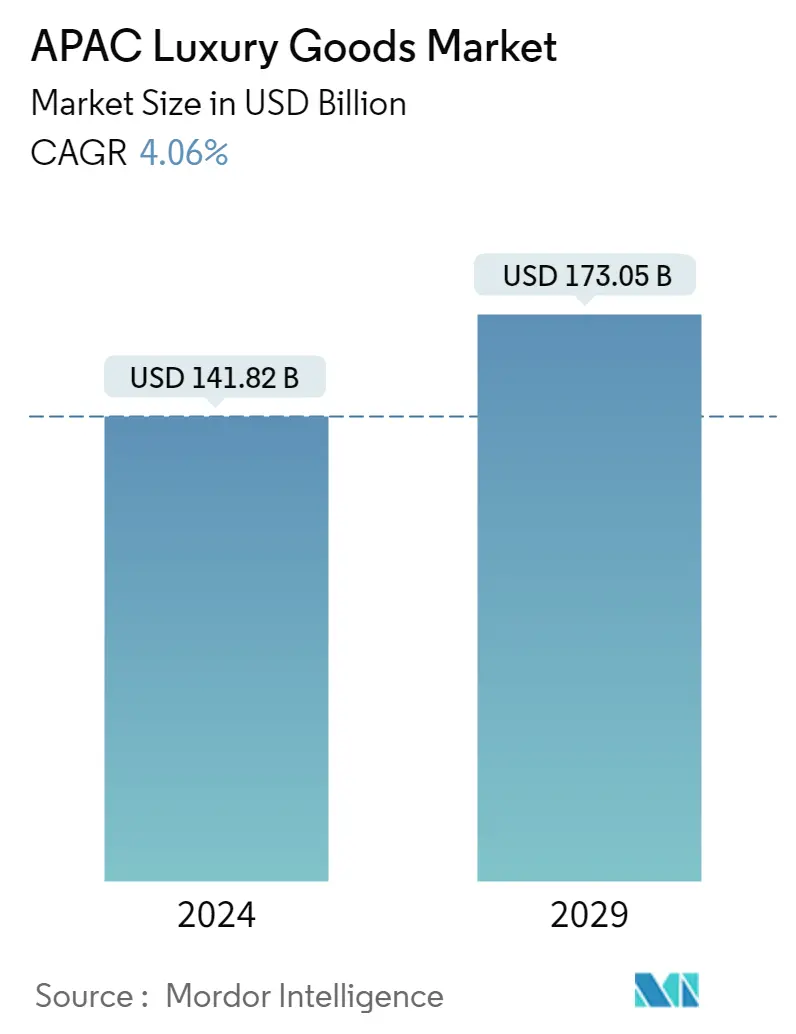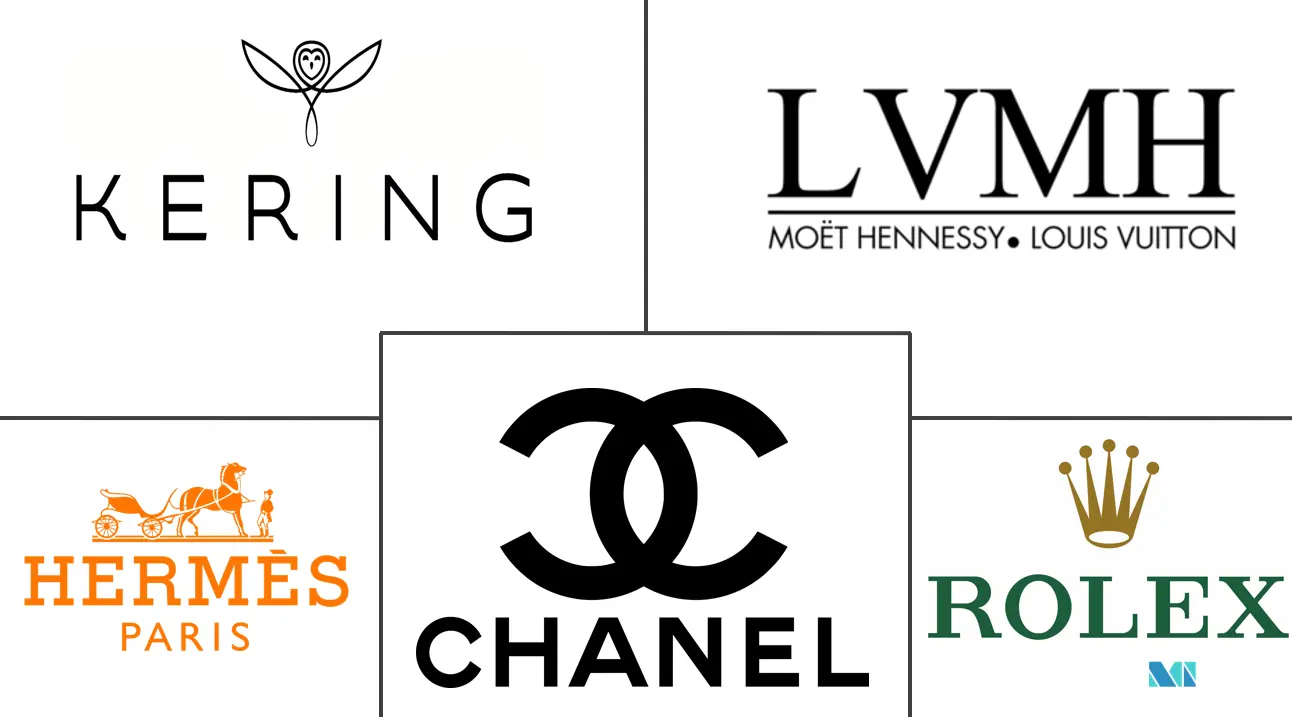Market Size of APAC Luxury Goods Industry

| Study Period | 2019 - 2029 |
| Base Year For Estimation | 2023 |
| Market Size (2024) | USD 141.82 Billion |
| Market Size (2029) | USD 173.05 Billion |
| CAGR (2024 - 2029) | 4.06 % |
| Market Concentration | Low |
Major Players
*Disclaimer: Major Players sorted in no particular order |
Asia Pacific Luxury Goods Market Analysis
The APAC Luxury Goods Market size is estimated at USD 141.82 billion in 2024, and is expected to reach USD 173.05 billion by 2029, growing at a CAGR of 4.06% during the forecast period (2024-2029).
The Asia-Pacific region is the world's largest consumer of luxury products and has grown to be a significant market for international luxury brands. In the Asia-Pacific region, China and Japan rank among the top consumers of luxury goods and have the highest average per capita incomes. According to Alibaba, the sales of luxury goods in China increased from 11% to 20% in 2020 as compared to the overall share of the global industry.
The Asian luxury market is in flux, with consumers demanding luxury goods from different backgrounds and starting points. A steady economy, rapidly changing consumer trends, the growth of boutique luxury brands, and the massive shift from physical to digital channels are creating a new competitive landscape for the luxury goods market. Younger consumers are helping to drive changes in luxury consumption and attitudes. They are heavily fixated on sustainability, and most luxury consumers say they prefer brands that are socially responsible.
The COVID-19 epidemic had a big effect on the luxury goods market, especially in this part of the world where many people have been forced to stay home because of travel bans and lockdowns.
Asia Pacific Luxury Goods Industry Segmentation
A luxury product is an expensive product that solely serves as a status symbol. Higher-income people generally purchase it to flaunt their affluence and gain social prestige. The Asia-Pacific luxury goods market is segmented by type, distribution channel, and geography. Based on type, the market is segmented into clothing and apparel, footwear, bags, jewelry, watches, and other types. Based on distribution channels, the market is segmented into single-brand stores, multi-brand stores, online stores, and other distribution channels. Based on geography, the market is segmented into China, Japan, India, Australia, South Korea, and the rest of Asia-Pacific. For each segment, the market sizing and forecasts have been done on the basis of value (in USD million).
| Type | |
| Clothing and Apparel | |
| Footwear | |
| Bags | |
| Jewelry | |
| Watches | |
| Other Types |
| Distribution Channel | |
| Single-branded Stores | |
| Multi-brand Stores | |
| Online Stores | |
| Other Distribution Channels |
| Geography | |
| China | |
| Japan | |
| India | |
| Australia | |
| South Korea | |
| Rest of Asia-Pacific |
APAC Luxury Goods Market Size Summary
The Asia-Pacific luxury goods market is a dynamic and rapidly evolving sector, characterized by its status as the largest consumer base for luxury products globally. This region has become a pivotal market for international luxury brands, with China and Japan leading in consumer spending and per capita income. The market is experiencing significant shifts due to changing consumer preferences, with younger consumers driving demand for sustainable and socially responsible luxury goods. The COVID-19 pandemic has further accelerated these changes, prompting a shift from physical to digital channels and increasing the focus on personalization and customization. Key players in the market are leveraging customer feedback and interaction platforms to enhance their offerings, with companies like XL Enterprises leading the way in customized luxury products.
The market landscape is highly competitive and fragmented, with major players such as LVMH, Chanel, Rolex, Hermès, and Kering actively engaging in mergers, acquisitions, and partnerships to strengthen their market presence. The Chinese market, in particular, is witnessing a surge in luxury spending, fueled by rising disposable incomes and a strong consumer confidence among younger generations. The government's efforts to reduce import duties and control gray markets have further encouraged domestic luxury purchases. Companies are expanding their product ranges and distribution channels, with digital platforms playing a crucial role in reaching consumers. Initiatives like Alibaba's Luxury Soho platform exemplify the strategic moves by brands to tap into the growing demand for luxury goods in the region.
APAC Luxury Goods Market Size - Table of Contents
-
1. MARKET DYNAMICS
-
1.1 Market Drivers
-
1.2 Market Restraints
-
1.3 Porter's Five Forces Analysis
-
1.3.1 Bargaining Power of Suppliers
-
1.3.2 Bargaining Power of Buyers
-
1.3.3 Threat of New Entrants
-
1.3.4 Threat of Substitute Products and Services
-
1.3.5 Degree of Competition
-
-
-
2. MARKET SEGMENTATION
-
2.1 Type
-
2.1.1 Clothing and Apparel
-
2.1.2 Footwear
-
2.1.3 Bags
-
2.1.4 Jewelry
-
2.1.5 Watches
-
2.1.6 Other Types
-
-
2.2 Distribution Channel
-
2.2.1 Single-branded Stores
-
2.2.2 Multi-brand Stores
-
2.2.3 Online Stores
-
2.2.4 Other Distribution Channels
-
-
2.3 Geography
-
2.3.1 China
-
2.3.2 Japan
-
2.3.3 India
-
2.3.4 Australia
-
2.3.5 South Korea
-
2.3.6 Rest of Asia-Pacific
-
-
APAC Luxury Goods Market Size FAQs
How big is the APAC Luxury Goods Market?
The APAC Luxury Goods Market size is expected to reach USD 141.82 billion in 2024 and grow at a CAGR of 4.06% to reach USD 173.05 billion by 2029.
What is the current APAC Luxury Goods Market size?
In 2024, the APAC Luxury Goods Market size is expected to reach USD 141.82 billion.

